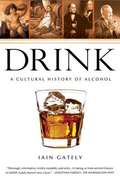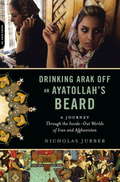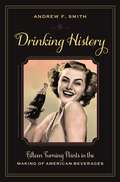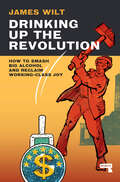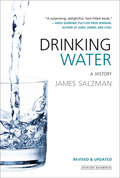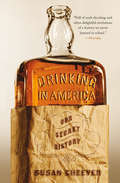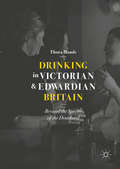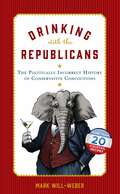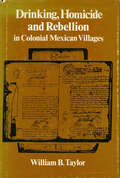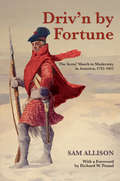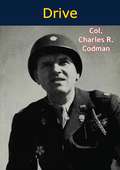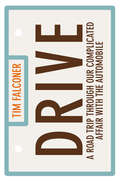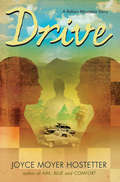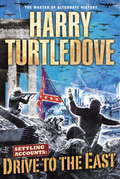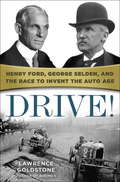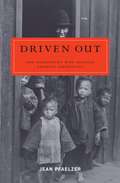- Table View
- List View
Drink, Temperance and the Working Class in Nineteenth Century Germany (Routledge Library Editions: German History #36)
by James S. RobertsOriginally published in 1984 this book provided the first German case study of a prototypical 19th Century social problem, combining a discussion of popular drinking behaviour with analysis of efforts to reform it on the parts of both middle class temperance reformers and the socialist labour movement. The book links the study of popular drinking behaviour and organized responses to it to larger themes in Germany’s social and political development, providing an important window on topics such as working class dietary standards to the political mentality of the Bildungsbügertum.
Drink: A Cultural History of Alcohol
by Iain GatelyA spirited look at the history of alcohol, from the dawn of civilization to the modern day Alcohol is a fundamental part of Western culture. We have been drinking as long as we have been human, and for better or worse, alcohol has shaped our civilization. Drink investigates the history of this Jekyll and Hyde of fluids, tracing mankind's love/hate relationship with alcohol from ancient Egypt to the present day. Drink further documents the contribution of alcohol to the birth and growth of the United States, taking in the War of Independence, the Pennsylvania Whiskey revolt, the slave trade, and the failed experiment of national Prohibition. Finally, it provides a history of the world's most famous drinks-and the world's most famous drinkers. Packed with trivia and colorful characters, Drink amounts to an intoxicating history of the world.
Drinker of Blood (The Lord Meren Mysteries #5)
by Lynda S. RobinsonA spy in ancient Egypt investigates who killed Queen Nefertiti in &“one of the most engrossing and sophisticated historical mystery series running&” (Publishers Weekly). Lord Meren serves as mentor—and eyes and ears—to the boy king Tutankhamun. But to keep the young pharaoh safe, he&’s keeping his investigation into the death of Nefertiti a secret. Meren has concluded succumbed to poison, not the plague, and he&’s narrowed his potential suspects down to three men. His clandestine efforts are interrupted when Tut asks him to look into a mysterious fatality at the royal zoo, but Meren remains focused—even when someone uses his own knife to make an attempt on Tut&’s life . . . &“The story has a dark, romantic power. . . . It&’s always a pleasure to negotiate the treacherous corridors of power with Lord Meren and his wily associates, eavesdropping on the priests in Pharaoh&’s court, ducking the knife fights on the back streets of Memphis—and picking up beauty tips from Nefertiti.&” —The New York Times Book Review &“A mesmerizing blend of tantalizing suspense, high-speed action, and gripping historical intrigue . . . An outstanding thriller.&” —Booklist
Drinking Arak Off an Ayatollah's Beard: A Journey Through the Inside-Out Worlds of Iran and Afghanistan
by Nicholas JubberAn engrossing blend of travel writing and history, Drinking Arak off an Ayatollah's Beard traces one man's adventure-filled journey through today's Iran, Afghanistan, and Central Asia, and describes his remarkable attempt to make sense of the present by delving into the past. Setting out to gain insight into the lives of Iranians and Afghans today, Nicholas Jubber is surprised to uncover the legacy of a vibrant pre-Islamic Persian culture that has endured even in times of the most fanatic religious fundamentalism. Everywhere--from underground dance parties to religious shrines to opium dens--he finds powerful and unbreakable connections to a time when both Iran and Afghanistan were part of the same mighty empire, when the flame of Persian culture lit up the world. Whether through his encounters with poets and cab drivers or run-ins with "pleasure daughters" and mujahideen, again and again Jubber is drawn back to the eleventh-century Persian epic, the Shahnameh ("Book of Kings"). The poem becomes not only his window into the region's past, but also his link to its tumultuous present, and through it Jubber gains access to an Iran and Afghanistan seldom revealed or depicted: inside-out worlds in which he has tea with a warlord, is taught how to walk like an Afghan, and even discovers, on a night full of bootleg alcohol and dancing, what it means to drink arak off an Ayatollah's beard.
Drinking Bomb and Shooting Meth: Alcohol and Drug Use in Japan (Asia Shorts)
by Jeffrey W. AlexanderIn Japan, beer has been known, since the 1960s, as the “beverage of the masses,” and whisky culture has roots stretching back to the 1950s. Meanwhile, methamphetamine was first developed in Japan and came to be sold commercially by the 1940s, and the country has also experimented with homegrown hangover drugs. By combining studies on each of these products and marketplaces, Drinking Bomb and Shooting Meth explores the efforts of those who brewed, distilled, synthesized, and marketed Western alcohol and innovative pharmaceuticals. Jeffrey W. Alexander asks how these products became so popular, available, and fashionable, and explores what their advertising campaigns say about Japan’s shifting culture, which is often quick to absorb and refine foreign wares. Alexander’s research highlights themes like the seedy reputation of early bars, the style of prewar beer advertising, the scourge of illicit postwar liquor, the promises offered by hangover pills, and the swift campaign to demonize meth and eradicate its use. Examining these products, as well as their innovators and advertisers, offers us unique and rich perspectives on Japan’s experience with drugs and alcohol.
Drinking History: Fifteen Turning Points in the Making of American Beverages (Arts and Traditions of the Table: Perspectives on Culinary History)
by Andrew SmithA companion to Andrew F. Smith's critically acclaimed and popular Eating History: Thirty Turning Points in the Making of American Cuisine, this volume recounts the individuals, ingredients, corporations, controversies, and myriad events responsible for America's diverse and complex beverage scene. Smith revisits the country's major historical moments—colonization, the American Revolution, the Whiskey Rebellion, the temperance movement, Prohibition, and its repeal—and he tracks the growth of the American beverage industry throughout the world. The result is an intoxicating encounter with an often overlooked aspect of American culture and global influence. Americans have invented, adopted, modified, and commercialized tens of thousands of beverages—whether alcoholic or nonalcoholic, carbonated or caffeinated, warm or frozen, watery or thick, spicy or sweet. These include uncommon cocktails, varieties of coffee and milk, and such iconic creations as Welch's Grape Juice, Coca-Cola, root beer, and Kool-Aid. Involved in their creation and promotion were entrepreneurs and environmentalists, bartenders and bottlers, politicians and lobbyists, organized and unorganized criminals, teetotalers and drunks, German and Italian immigrants, savvy advertisers and gullible consumers, prohibitionists and medical professionals, and everyday Americans in love with their brew. Smith weaves a wild history full of surprising stories and explanations for such classic slogans as "taxation with and without representation;" "the lips that touch wine will never touch mine;" and "rum, Romanism, and rebellion." He reintroduces readers to Samuel Adams, Thomas Jefferson, George Washington, and the colorful John Chapman (Johnny Appleseed), and he rediscovers America's vast literary and cultural engagement with beverages and their relationship to politics, identity, and health.
Drinking Up the Revolution: How to Smash Big Alcohol and Reclaim Working-Class Joy
by James WiltJames Wilt exposes the links between the global alcohol industry and capitalism.In Drinking Up the Revolution, James Wilt shows us why alcohol policy should be at the heart of any socialist movement.Many people are drinking more now than ever before, as already massive multinationals are consolidating and new online delivery services are booming in an increasingly deregulated market. At the same time, public health experts are sounding the alarm about the catastrophic health and social impacts of rising alcohol use, with over three million people dying ever year due to alcohol-related harms.Exposing the links between the alcohol industry and capitalism, colonialism and environmental destruction, Wilt demonstrates the failure of both prohibition and deregulation, and instead focuses on those who profit from alcohol&’s sale and downplay its impacts: producers, retailers, and governments.Rejecting both the alcohol industry&’s moralizing against individual &“problem drinkers&” and the sober politics of &“straight-edge&” and wellness lifestyle trends, Drinking Up the Revolution is not another call for prohibition or more governmental control, but is instead a cry to take back alcohol for the people, and make it safe and enjoyable for all those who want to use it.
Drinking Water: A History
by James SalzmanAn in-depth look at the changing approaches that environmentalists, governments, and the open market have taken to water through the lens of world history. When we turn on the tap or twist open a tall plastic bottle, we probably don&’t give a second thought about where our drinking water comes from. But how it gets from the ground to the glass is far more convoluted than we might think. In this revised edition of Drinking Water, Duke University professor and environmental policy expert James Salzman shows how drinking water highlights the most pressing issues of our time. He adds eye-opening, contemporary examples about our relationship to and consumption of water, and a new chapter about the atrocities that occurred in Flint, Michigan. Provocative, insightful, and engaging, Drinking Water shows just how complex a simple glass of water can be.&“A surprising, delightful, fact-filled book.&” —Jared Diamond, Pulitzer Prize–winning author of Guns, Germs, and Steel &“Instead of buying your next twelve-pack of bottled water, buy this fascinating account of all the people who spent their lives making sure you&’d have clean, safe drinking water every time you turned on the tap.&” —Bill McKibben, author of Earth: Making a Life on a Tough New Planet &“Drinking Water effortlessly guides us through a fascinating world we never consider. Even for people who think they know water, there is a surprise on almost every page.&” —Charles Fishman, bestselling author of The Big Thirst and The Wal-Mart Effect &“Salzman puts a needed spotlight on an often overlooked but critical social, economic, and political resource.&” —Publishers Weekly
Drinking in America: A History (Revised and Expanded Edition)
by Mark Edward Lender James K. MartinDrinking in America is meant to bring original research together with the best of the new historical and social science investigations and to put forth our own interpretation of what drinking (or, for that matter, not drinking) has meant to passing generations of Americans.
Drinking in America: Our Secret History
by Susan CheeverIn DRINKING IN AMERICA, bestselling author Susan Cheever chronicles our national love affair with liquor, taking a long, thoughtful look at the way alcohol has changed our nation's history. This is the often-overlooked story of how alcohol has shaped American events and the American character from the seventeenth to the twentieth century. Seen through the lens of alcoholism, American history takes on a vibrancy and a tragedy missing from many earlier accounts. From the drunkenness of the Pilgrims to Prohibition hijinks, drinking has always been a cherished American custom: a way to celebrate and a way to grieve and a way to take the edge off. At many pivotal points in our history-the illegal Mayflower landing at Cape Cod, the enslavement of African Americans, the McCarthy witch hunts, and the Kennedy assassination, to name only a few-alcohol has acted as a catalyst.Some nations drink more than we do, some drink less, but no other nation has been the drunkest in the world as America was in the 1830s only to outlaw drinking entirely a hundred years later. Both a lively history and an unflinching cultural investigation, DRINKING IN AMERICA unveils the volatile ambivalence within one nation's tumultuous affair with alcohol.
Drinking in Victorian and Edwardian Britain: Beyond the Spectre of the Drunkard
by Thora HandsThis open access book surveys drinking in Britain between the Licensing Act of 1869 and the wartime regulations imposed on alcohol production and consumption after 1914. This was a period marked by the expansion of the drink industry and by increasingly restrictive licensing laws. Politics and commerce co-existed with moral and medical concerns about drunkenness and combined, these factors pushed alcohol consumers into the public spotlight. Through an analysis of public and private records, medical texts and sociological studies, the book investigates the reasons why Victorians and Edwardians consumed alcohol in the ways that they did and explores the ideas about alcohol that circulated in the period. This book shows that they had many reasons for purchasing and consuming alcoholic substances and these were driven by broader social, cultural, medical and commercial factors. Although drunkenness may have been the most visible consequence of alcohol consumption, it was not the only type of drinking behaviour. Alcohol played an important social role in the everyday lives of Victorians and Edwardians where its consumption held many different meanings.
Drinking with the Democrats: The Party Animal's History of Liberal Libations
by Mark Will-WeberThis election year, celebrate the Democratic Party by drinking like a Democrat! Organized by president, this fun gift book is full of cocktail recipes, bar tips, and hysterical drinking anecdotes from all Democratic White House administrations. <P><P>Which Southern man drank Snakebites? How did Jackie-O like her daiquiris? Drinking with the Democrats is the bar guide with a twist that all political buffs will enjoy!(Also check out the companion book, Drinking with the Republicans.)
Drinking with the Republicans: The Politically Incorrect History of Conservative Concoctions
by Mark Will-WeberThis election year, celebrate the Republican Party by drinking like a Republican! Organized by president, this fun gift book is full of cocktail recipes, bar tips, and hysterical drinking anecdotes from all Republican White House administrations. Which president liked to mix whiskey, vodka, and orange juice? Who had a trick for hiding the labels of cheap wine? Drinking with the Republicans is the bar guide with a twist that all political buffs will enjoy!(Also check out the companion book, Drinking with the Democrats.)
Drinking, Homicide, and Rebellion in Colonial Mexican Villages
by William B. TaylorThis book is about patterns of social behavior in Indian peasant communities of central and southern Mexico after the severe hazards of the sixteenth century had passed, leaving the pressures of a mature colonial system on the lives of an expanding population. Without attempting to force connections among peasant norms, behavior, and circumstances, I am interested in what colonial peasants believed and said about themselves, what they actually did and said in specific situations, and what their relations were to the powerful outsiders whose presence defined their position as peasants.
Drishti Bhartiya Arthvyavastha Competitive Exam
by Indic TrustAll the important concepts that show the Indian economy to the initial test, in which more than fifty percent of questions related to the economy are related to our ' Indian economy ' Book It will be our endeavor that we can fulfill the expectations of our readers and in their success.
Drishti Kala Evam Sanskriti Competitive Exam
by Indic TrustThe Art and Culture is ussally it is a part of history topic. Civil Services Examination. In preparing for the questions related to this ,after reading the books related to the history.
Drishti Prasan Sangrah Competitive Exam
by Indic TrustThis book is a collections long type questions for the prepration of IAS MAINS exams.
Driv'n by Fortune: The Scots' March to Modernity in America, 1745–1812
by Sam AllisonA provocative account of the 78th Fraser’s Highlanders and its crucial place in history. The remarkable story of the men of the 78th Fraser’s Highlanders moves from the 1745 Jacobite Rebellion in Scotland, through the Seven Years’ War and the American Revolution, to the War of 1812. Simon Fraser, chief of the Clan Fraser of Lovat, raised the 78th Highlanders, a regiment that played a major role in defeating the French on the Plains of Abraham. Driv’n by Fortune tackles the myths embedded in nationalistic history and in fictional accounts of these Highland soldier-settlers who brought the Scottish Enlightenment to North America. The impact of the 78th Fraser’s Highlanders, which extended far beyond Scotland and the Canada of their times, is finally being told.
Drive
by Col. Charles R. CodmanHaving fought with distinction (winning the Silver Star and the Croix de Guerre) in the First World War as a pilot, Charles Russell Codman retired back to civilian life believing that his fighting days were over. However he re-entered the army to fight on the side of Democracy once again, and before long his unique qualifications led him to being appointed as aide-de-camp to no lesser general than George S. Patton Jr. This book is the fascinating story of Codman's experiences as part of General Patton's staff from the sands of North Africa to eventual victory in Germany. A rare insight into the wartime career at the headquarters of America's finest fighting general of the Second World War."THIS book is compiled from letters written to my wife during thirty-three months of service (1942-1945) in the European theater of operations during World War II."At the end of the North African campaign, I was appointed A.D.C. to General George S. Patton, Jr., serving from then on as his senior aide-de-camp until after V-E Day and his return to the United States. While General Patton is naturally the central and dominating figure of this journal, the latter is in no sense an attempt at either biography or military analysis."--The Author
Drive
by Tim FalconerLiberation, lust, envy, rage, power, thrill--our cars provoke enough emotion to jam a six-lane highway. If you name your ride, reminisce about sex in the back seat or enjoy roaring down the open road, you know why we love our wheels. But if you hate traffic, curse at the price at the pump or fight over parking spaces, you know why we hate them too. Drive is a cross-continent adventure that explores where our fuel-injected dreams have taken us. Award-winning journalist Tim Falconer invites us on his road trip as he meets vintage car enthusiasts on Route 66, rides along in a police cruiser, kicks the tires at a Las Vegas auto show and takes a hydrogen-powered car for a spin. Steering us along North America's interstates and blue highways, meandering through small towns, sprawling suburbs and walkable neighbourhoods, Falconer shows us the growing collision of cars and people. In this complicated affair, who's really in the driver's seat? Can smart growth, public transit and complete streets free us? A spirited, front-seat view of quirky locals and locales, Drive looks at what auto-dominated life means to our health, environment and communities. Falconer also opens the door on British and Argentine car cultures, and considers the road ahead for China and India, nations with increasingly American attitudes. As billions grab their keys, can we avoid carmageddon? "[A] fascinating survey of the automobile and its effect on society ... A fun book about a serious topic." --Winnipeg Free Press "Essential reading for any Canadian intrigued by the conundrum of finding better ways to get from here to there." --Spacing magazine
Drive (Bakers Mountain Stories)
by Joyce Moyer HostetterThis fourth title in the best-selling Bakers Mountain Stories series by Joyce Moyer Hostetter focuses on the relationship between twin sisters Ida and Ellie Honeycutt, who find themselves growing apart as they respond differently to their father’s post–World War II trauma, the NASCAR speedway, and their new high school. With home life destabilized by her father’s postwar trauma, Ellie Honeycutt seeks escape at the NASCAR speedway and in her dreams of travel and college. On the other hand, her twin sister, Ida, clings to family and finds solace in her sketchbook. Their close relationship is threatened when they both fall for the same charming classmate at their new high school. But a devastating car accident forces them to change roles and, ultimately, renews the sisters’ deep bond. Set against the backdrop of the nuclear arms race and the 1952 presidential election, this compelling coming-of-age story is told in the twins’ alternating voices. The book concludes with an author’s note and further resources.
Drive to the East (Settling Accounts #2)
by Harry TurtledoveHarry Turtledove–the master of alternate history–has recast the tumultuous twentieth century and created an epic that is powerful, bold, and as convincing as it is provocative. In Drive to the East he continues his saga of warfare that has divided a nation and now threatens the entire world. In 1914, the First World War ignited a brutal conflict in North America, with the United States finally defeating the Confederate States. In 1917, The Great War ended and an era of simmering hatred began, fueled by the despotism of a few and the sacrifice of many. Now it’s 1942. The USA and CSA are locked in a tangle of jagged, blood-soaked battle lines, modern weaponry, desperate strategies, and the kind of violence that only the damned could conjure up–for their enemies and themselves. In Richmond, Confederate president and dictator Jake Featherston is shocked by what his own aircraft have done in Philadelphia–killing U.S. president Al Smith in a barrage of bombs. Featherston presses ahead with a secret plan carried out on the dusty plains of Texas, where a so-called detention camp hides a far more evil purpose. As the untested U.S. vice president takes over for Smith, the United States face a furious thrust by the Confederate army, pressing inexorably into Pennsylvania. But with the industrial heartland under siege, Canada in revolt, and U.S. naval ships fighting against the Japanese in the Sandwich Islands, the most dangerous place in the world may be overlooked.
Drive!: Henry Ford, George Selden, and the Race to Invent the Auto Age
by Lawrence GoldstoneFrom the acclaimed author of Birdmen comes a revelatory new history of the birth of the automobile, an illuminating and entertaining true tale of invention, competition, and the visionaries, hustlers, and swindlers who came together to transform the world. In 1900, the Automobile Club of America sponsored the nation's first car show in New York's Madison Square Garden. The event was a spectacular success, attracting seventy exhibitors and nearly fifty thousand visitors. Among the spectators was an obscure would-be automaker named Henry Ford, who walked the floor speaking with designers and engineers, trying to gauge public enthusiasm for what was then a revolutionary invention. His conclusion: the automobile was going to be a fixture in American society, both in the city and on the farm--and would make some people very rich. None, he decided, more than he. Drive! is the most complete account to date of the wild early days of the auto age. Lawrence Goldstone tells the fascinating story of how the internal combustion engine, a "theory looking for an application," evolved into an innovation that would change history. Debunking many long-held myths along the way, Drive! shows that the creation of the automobile was not the work of one man, but very much a global effort. Long before anyone had heard of Henry Ford, men with names like Benz, Peugeot, Renault, and Daimler were building and marketing the world's first cars. Goldstone breathes life into an extraordinary cast of characters: the inventors and engineers who crafted engines small enough to use on a "horseless carriage"; the financiers who risked everything for their visions; the first racers--daredevils who pushed rickety, untested vehicles to their limits; and such visionary lawyers as George Selden, who fought for and won the first patent for the gasoline-powered automobile. Lurking around every corner is Henry Ford, a brilliant innovator and an even better marketer, a tireless promoter of his products--and of himself. With a narrative as propulsive as its subject, Drive! plunges us headlong into a time unlike any in history, when near-manic innovation, competition, and consumerist zeal coalesced to change the way the world moved. Advance praise for Drive!"A wonderful, story-filled saga of the early days of the auto age . . . Readers will be swept up in his vivid re-creation of a bygone era. . . . 'Horse Is Doomed,' read one headline in 1895. This highly readable popular history tells why."--Kirkus Reviews (starred reviews)"A splendid dissection of the Selden/Ford patent face-off and its place in automotive historiography, this work will be enjoyed by business, legal, transportation, social, and intellectual historians; general readers; and all libraries."--Library Journal (starred review) "This book contains the great names in automotive history--the Dodge brothers, Barney Oldfield, all the French (they seemed, until Ford, to lead the Americans in development of the vehicle)--and it is fascinating. . . . An engaging new take on the history of technological innovation."--Booklist "Business history as you have never read it before. Lawrence Goldstone tells the tale of the important but now forgotten legal fight over the patent for the automobile. With more plot twists than a murder mystery and a cast of well-known industrial titans, Drive! takes the reader down the road from the dawning age of the automobile, when Henry Ford's dream almost turned into a nightmare."--James McGrath Morris, author of Pulitzer: A Life in Politics, Print, and PowerFrom the Hardcover edition.
Drive: How To Drive Racing Cars Step By Step (DK Definitive Visual Histories)
by DKFrom the first horseless carriage to the AI automobile, this book offers a complete timeline of the history of cars and a colorful insight into their futureCharting over a century of progress--from horseless carriages to driverless vehicles--this is a stunning visual celebration of the motorcar and the romance of the open road.Beginning with the birth of the internal combustion engine, Drive explores how this once rare and luxurious status symbol has become a staple of everyday life. It shows you the ways in which the automobile has influenced breakthroughs in new technology and design, while becoming the focal point of an exhilarating genera of sport. Taking you on a journey along Route 66, inside the engine of a sports car, and into the lives of the most successful pioneers of automobile history, the book also explores the possibilities of the "green" car, the electric motor, and AI technology of the future. Combining rarely seen images, insightful biographies. and fascinating features, Drive illustrates how after more than a century of development, the car still conveys a sense of freedom, excitement, and desire.
Driven Out
by Jean PfaelzerDriven Outexposes a shocking story of ethnic cleansing in California and the Pacific Northwest when the first Chinese Americans were rounded up and purged from more than three hundred communities by lawless citizens and duplicitous politicians. <P><P> From 1848 into the twentieth century, Chinatowns burned across the West as Chinese miners and merchants, lumberjacks and fieldworkers, prostitutes and merchants' wives were violently loaded onto railroad cars or steamers, marched out of town, or killed. But the ...

